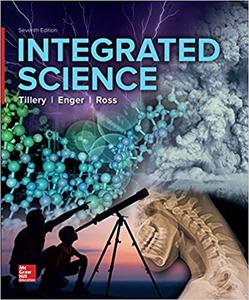
Frederick C. Tillery, Bill W.; Enger, Eldon D.; Ross, "Integrated Science"
English | 2018 | ISBN: 1259350436, 0072297662 | PDF | pages: 831 | 152.4 mb
Integrated Science is a straightforward and easy-to-read but substantial introduction to the fundamental behavior of matter and energy in living and nonliving systems. It meets the needs of non-science majors who must complete one or more science courses as part of a general or basic studies requirement.
Integrated Science provides an introduction to a scientific way of thinking as it introduces fundamental scientific concepts, often in a historical context. Several features of the text provide opportunities for students to experience the methods of science by evaluating situations from a scientific point of view. Although technical language and mathematics are important in developing an understanding of science, only the language and mathematics needed to develop central concepts are used. No prior work in science is assumed.
Many features, such as Science and Society readings, as well as basic discussions of the different branches of science help students understand how they relate. These connections allow students to develop an appreciation of the major developments in science and an ability to act as informed citizens on matters that involve science and public policy.
The Integrated Science sequence of chapters is flexible, and the instructor can determine topic sequence and depth of coverage, as needed. The materials support a conceptual approach or a combined conceptual and problem-solving approach.
The Integrated Science Online Learning Center's Instructor's Resources offer suggestions for integrating the text's topics around theme options. With laboratory studies, the text contains enough material for the instructor to select a sequence for a one- or two-semester course.
The goals of Integrated Science are as follows:*Create an introductory science course aimed at the non-science major.*Introduce a course that presents a coherent and clear picture of all science disciplines through an interdisciplinary approach.*Help instructors build their own mix of descriptive and analytical aspects of science, arousing student interest and feelings as they help students reach the educational goals of their particular course.*Humanize science for non-science majors.
New to This Edition*The text features several new worked Examples and end-of-chapter Parallel Exercises.*The new Science Sketch feature engages students in creating their own explanations and analogies by challenging them to create visual representations of concepts.*The new Self Checks feature allows students to check their understanding of concepts as they progress through the chapter.*The illustrations within the biological content have been revised to reduce their complexity.*Chapter 13 includes many new images and updated information from the latest space missions. *Chapter 16 contains additional information on distances in space.*Chapter 17 includes the most recent information on climate change, causes of global climate change, and global warming.
The Connect digital learning platform includes SmartBook, an adaptive digital version of the course textbook, that personalizes your reading experience based on how well you are learning the content; provides access to your instructor's homework assignments, quizzes, syllabus, notes, reminders, and other important files for the course; and offers progress dashboards that quickly show how you are performing on your assignments and tips for improvement
Please Help Me Click Connect Icon Below Here and Share News to Social Network | Thanks you !

